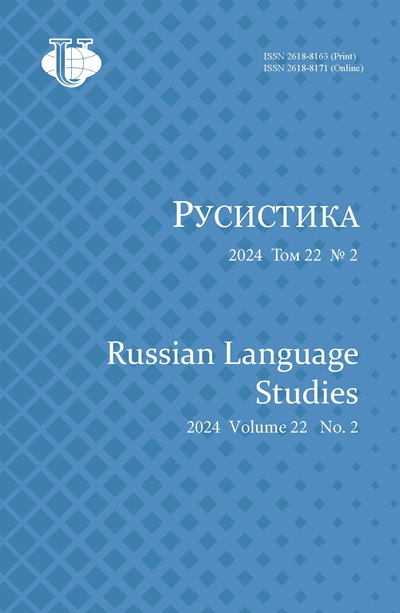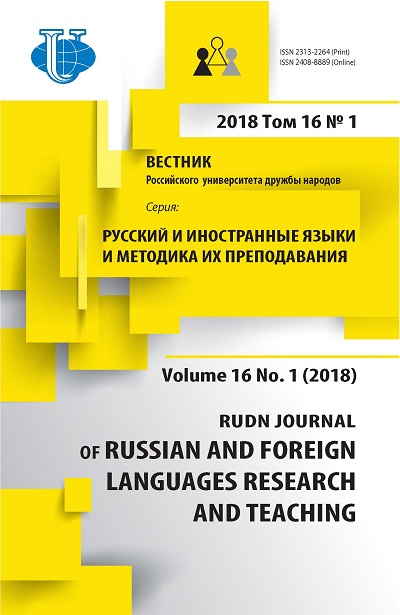Русский язык в Венгрии: от прошлого к будущему
- Авторы: Хамшовски С.А.1
-
Учреждения:
- Будапештский экономический университет прикладных наук
- Выпуск: Том 16, № 1 (2018)
- Страницы: 7-26
- Раздел: Русский язык в мировом пространстве
- URL: https://journals.rudn.ru/russian-language-studies/article/view/18011
- DOI: https://doi.org/10.22363/2313-2264-2018-16-1-7-26
Цитировать
Полный текст
Аннотация
В статье рассматриваются история становления преподавания и научного исследования русского языка в Венгрии. Автор в хронологическом порядке описывает процесс формирования преподавания русского языка от его возникновения до наших дней, включая компоненты его эволюции, и обращает внимание читателей на влияние исторических и геополитических процессов на объект исследования. Наметившееся повышение интереса к изучению русского языка в Венгрии связано с происходящим в последнее время процессом развития торгово-экономических и культурных связей Венгрии и России, укреплением позиций России и по другим направлениям. На рынке труда увеличивается потребность в венгерских специалистах, достаточно свободно владеющих русским языком и способных стать активными участниками происходящего процесса укрепления двусторонних связей. Процесс овладения русским языком на необходимом для общения и решения профессиональных задач уровне усложняется тем, что преподавание ведется в условиях отсутствия языковой среды. Начинающие изучать русский язык сразу же сталкиваются с трудностями, вызванными не только отличиями кириллицы от латиницы, но и многозначностью некоторых наиболее часто употребляемых слов, флективностью русского языка, наличием двух основ у глаголов, употреблением глаголов движения и видовых пар глаголов. Более того, после перехода высшего образования на Болонскую систему значительно сократилось количество учебных часов. что ставит как перед учащимися, так и перед преподавателями сложные задачи. Количество учебных часов в вузах на нефилологических специальностях в настоящее время составляет не более 60 часов в семестр. Будущие экономисты, маркетологи, работники сферы туризма и гостиничного хозяйства рассчитывают начать изучение русского языка с нуля и за время обучения в бакалавриате, т.е. не более, чем за 360 аудиторных занятий на протяжении шести семестров, овладеть не только языком повседневного общения, но и сдать государственный экзамен по деловому русскому языку (уровень В 2), который, наряду с подтвержденным знанием другого иностранного языка, дает право выпускнику получить диплом. Несмотря на эти сложности, студенты выбирают русский язык в качестве второго или третьего иностранного языка.С помощью диагностических методов исследования описываются процессы становления преподавания русского языка и мотивации к его изучению на территории Венгрии.
Об авторах
Светлана Алексеевна Хамшовски
Будапештский экономический университет прикладных наук
Автор, ответственный за переписку.
Email: hamsovszki.szvetlana@uni-bge.hu
кандидат педагогических наук, профессор кафедры иностранных языков факультета внешней торговли Будапештского экономического университета прикладных наук. Сфера научных интересов: методика преподавания русского языка как иностранного, тестирование, психолингвистика. Автор 40 научных публикаций. Председатель Венгерской ассоциации преподавателей русского языка и литературы
Список литературы
- Бакони Иштван. Основные направления в методике преподавания русского языка в Венгрии: базовое, профессиональное и деловое обучение: дисс. … д-ра пед. наук. М., 2001. 326 с
- Болла К., Палл Э., Папп Ф. Курс современного русского языка / под ред. Ф. Паппа. 4-е изд. Будапешт, 1977
- Варга Ева Мария. Вместо предисловия. Российская белая эмиграция в Венгрии (1920-1940-е годы). М.: ПРOБЕЛ, 2012
- Вегвари Валентина. Кафедра славянской филологии Печского университета (прошлое, настоящее и будущее) / Юбилейный сб. науч. тр., посвященный 165-летию преподавания русского языка в Венгрии. Печ: Печский университет, 2015. С. 50-58
- Золтан А. Interslavica. Исследования по межславянским языковым и культурным контактам. М.: Институт славяноведения, 2014. 224 с
- Крекич Й. Семантическое влияние внутренних и внешних факторов на лексическое значение начинательных глаголов с приставками за- и по-. Diss. Slavicae, XII, Szeged, 1977. C. 125-146
- Лендваи Э. Прагмалингвистический портрет русского анекдота. Pécs, 2006. 330 с.
- Пете И. Синтаксис русского языка для венгерских студентов-русистов. Будапешт, 1991.
- Пете И. Иллюстрированная фразеология русского языка. 3-е изд. Szeged, 2001. 206 с.
- Сабов К.А. Грамматика письменного русского языка. Ужгород, 1865.
- Свак Д., Биро З., Силади А., Чоба Л., Краус Т. Ельцинщина. Будапешт: Центр русистики, 1993.
- Татар Б. Фразеология современного русского языка. Будапешт, 1992. 371 с.
- Федосов В.А. Рецензия. Двенадцать столетий венгерско-русских отношений. 2015. [Электронный ресурс]. URL: http://www.russtudies.hu/Aindex.php?dir=&menu=57&lang=r (дата обращения: 25.11.2017).
- Федосов В.А. Первые в Венгрии «Русские грамматики» (ХIХ - начало ХХ в.) / Юбилейный сб. науч. тр., посвященный 165-летию преподавания русского языка в Венгрии. Печ: Печский университет, 2015. С. 156-179
- Федосов В.А. Советско-венгерское сотрудничество в подготовке преподавателей русского языка для Венгрии (в 60-80-ые годы ХХ века) [Электронный ресурс]. URL: http://www. russtudies.hu/Aindex.php?dir=&menu=84&lang=h (дата обращения: 17.11.2017).
- Федосов В. А. Русский язык в Венгрии Научные исследования. Будапешт: Tolsztoj Társaság - Argumentum, 2015. 521 с
- Хидаши Юдит - Тромбиташ Эндре. История обучения русскому языку на Факультете внешней торговли БЭИ / Юбилейный сб. науч. тр., посвященный 165-летию преподавания русского языка в Венгрии. Печ: Печский университет, 2015. C. 184-188
- Янкович М. Русско-венгерский и венгерско-русский словарь аббревиатур и сложно сокращен- ных слов. Szombathely: BDF, 2003. 86 с
- Ясаи Л. Видовая пара по отношению к лексеме. Будапешт: Studia Russica VII, 1984. С. 21-34.
- Bakonyi István. Az orosz nyelv oktatása Magyarországon. Győr - Budapest. 2000. 191 c.
- Cs. Jónás Erzsébet. Kognitív szemantika a fordításban. Orosz kognitív nyelvészet. Alkalmazott Nyelvészeti Közlemények, Miskolc, VI. évfolyam, 1. 2012. 149 c.
- Fenyvesi István. Orosz-magyar és magyar-orosz szlengszótár. Budapest, 2001.
- Ferenczy Gyula. Orosz nyevtan és nyelvhasználat, Budapest: Nemzeti Tankönyvkiadó, 1996.
- Fodor Zója. Деловой русский. Как подготовиться к экзамену. Budapest: Nemzeti Kiadó, 2004. 170 oldal.
- Fodor Zója. Деловой русский (CD Hangfelvétel), Budapest: Nemzeti Tankönyvkiadó, 2004. 152 oldal.
- Gyáfrás Edit, Gyurácz Annamária, Kugler Katalin, Zakonova Dina. Orosz-magyar, magyar-orosz tanulószótár. Budapest: Grimm Könyvkiadó, 2015. 1376 oldal.
- Hamsovszki Szvetlana. Alaptársalgás oroszul A2-B1. Budapest: Lexika Kiadó, 2015. 157 oldal.
- Kiss Kálmán. Az orosz nyelv az 1945 előtti Magyarországon. 2015. [Электронный ресурс]. URL: http://oroszkozpont.pte.hu/sites/oroszkozpont.pte.hu/files/1.ch_sborn.pdf (дата обращения: 17.11.2017).
- Koósz Margit (Pécs, Magyrország) Orosznyelv-oktatás a 80-as években a magyar felsőoktatásban. [Электронный ресурс]. URL: http://oroszkozpont.pte.hu/sites/oroszkozpont.pte.hu/files/1.ch_sborn. pdf (дата обращения: 26.11.2017)
- Mágocsi Nyina, Kalafatics Zsuzsanna. Társalgás, szituációk, képleírások és hallás utáni szövegértés oroszul, Budapest: Lexika Kiadó, 2016. 277 oldal.
- Oszipova Irina. Kulcs 1-2. Orosz nyelvkönyv és munkafüzet. Budapest: Corvina Kiadó, 2008. 203 oldal.
- Székely András, Székely Nyina. Sag za sagom 1-2. Orosz nyelvkönyv és munkafüzet. Budapest: Nemzeti Tankönyvkiadó, 2012. 112 oldal.
- Székely Gábor. A lexikai fokozás. Budapest: Scholastica, 2001. 26 oldal.
- Trombitás Endre. Orosz üzleti nyelv. Budapest: Lucidus Kiadó, 2016. 424 oldal.
- Zoltán András. Szavak, szólások, szövegek Nyelvészeti és filológiai tanulmányok, Budapest: Lucidus Kiadó, 2005. 273 oldal.
- Vujovits Inessza-Dancz Péter. «Это надо знать» Orosz nyelvtani gyakorlókönyv. Budapest: Nemzeti tankönyvkiadó, 2004. 192 oldal.















